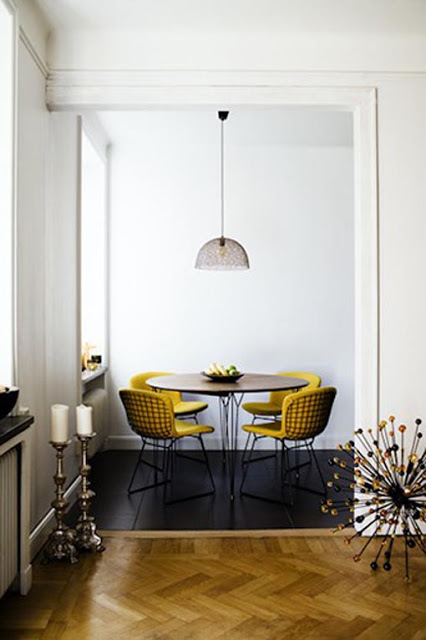
A historic apartment with a wonderful and modern interior, located in Paris, France. Photo via Airbnb.
Recently, I toured a house as a potential listing and I was blown away by the interior design. This was a historic home, and a lot of its original wood work, windows, and other architectural details survived. The furniture, however, was strikingly modern. Not only did it “work,” but it really looked great. The clean lines and the simplicity of the furniture allowed those one-of-a-kind historic details — which I thought were the main selling points of the home — to stand out. It seemed like a real win-win. The unique woodwork, high ceilings, and original elements were certainly on display, but so was the homeowner’s great modern taste.

Over-stuffed Charles Eastlake Interior Design Style, c. 1890. Photo via Hubpages.
This really successful juxtaposition of modern furniture and historic details got me to thinking about historic preservation and the Standards for Rehabilitation, which are a guide for preservationists and planners who make alterations to historic buildings. But you knew that! One key part of the ninth standard is, “The new work will be differentiated from the old and will be compatible with the historic materials, features, size, scale and proportion, and massing to protect the integrity of the property and its environment.” Basically, if you’re going to add something to a historic building, conventional wisdom says it’s best to honor, but not mimic, what’s already there. While the Standards are usually used in a more architectural application, I think this line of thinking applies pretty readily to furniture, décor, and staging of historic homes.
Think about it — originally, these Victorian-era homes would have been overstuffed with tons of furniture, rugs, drapes, plants, crazy patterned wallpaper, you name it. Charles Eastlake, a 19th-century British architect, wrote a book called Hints on Household Taste in 1862 which basically advised stylish homeowners that when it came to decorating, MORE WAS MORE.
For a while, this knick-knacky, jumbled aesthetic became synonymous with the “restoration” movement of the 20th century, when people thought “restoration” meant “put up some cabbage rose wallpaper and fill the home with a bunch of old crap.” While it’s generally good to consider and honor the era of your home’s construction when you’re renovating or redecorating, it doesn’t have to be so literal. Or expensive — all those antiquey knick-knacks add up! Better to buy one gorgeous Scandinavian dining table that fills a space with style on its own than thirteen Jenny Lind end tables with hand-tatted doilies.

Le Corbusier style Grand Confort Chairs in an ornate room at Place St. George
Adding sleek, modern furniture to a space that already comes with built-in texture in the way of historic millwork, plaster moldings, and ornate fireplaces brings those background elements out to play. These elements are now focal points in your home, not nice features that your guest will never notice because they’re hidden under seven layers of chintz.
Modern furniture, besides being objectively beautiful, lends itself to this application through its inherent simplicity. If Eastlake was all about “more is more,” the modernist aesthetic is absolutely “less is more.” Materials and characteristics of modern furniture, like laminated bent wood, steel, chrome, and the minimalist aesthetic lend themselves well to setting off the complex molding profiles, plaster, and floors of a historic character home. Modernist pieces in a historic room kind of do their own thing, in my opinion. They’re not competing with the historic space, but complementing its grandeur.
And minimalism isn’t the only brand of modernism. Bold colors and cool textures also do a lot of the same work in historic spaces. Take a tour of this historic apartment, featured in Design Milk, with modern style throughout. Apartment Therapy is another great resource for this kind of thing — they’re always posting inspirational “house tours” of homes with old bones but hip aesthetic.
While it’s no secret that a lot of today’s buyers might be repelled by a stately Victorian house decorated to the nines in the style of Charles Eastlake, a house with simple furniture, of the right scale, with clean lines, will show off the original features of the home and attract buyers to the character they originally wanted. It’s chic, sure, but it also makes historic buildings more accessible.

A pop of color in a small dining room.
By the way, this trend isn’t just confined to residential spaces. In fact, commercial interiors get redecorated all the time. All the time. Think about all the historic office buildings in your city that have floor after floor of cubicles and commercial carpeting as far as the eye can see. But let’s not get too snarky – there are good examples, too.
Here in Chicago, we’ve got a bunch. One of the most recent is the Virgin Hotel, which opened last year inside the Old Dearborn Bank Building. I love that from the outside, it could very well still be a classic Chicago School office building, but the inside is a fun modernist surprise. And the juxtaposition of the sleek, spaceship-looking bar against that textural historic coffered ceiling is to die for.
Who’s buying?

Let’s discuss how successful this combo of old and new is over drinks? Photo via US Green Building Council.